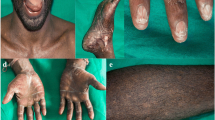Summary
Dyskeratosis congenita is an X-linked recessive disorder with diagnostic dermatological features, bone marrow hypofunction, and a predisposition to neoplasia in early adult life. Linkage analysis was undertaken in an extensive family with the condition using the Xg blood group and 17 cloned X chromosomal DNA sequences which recognise restriction fragment length polymorphisms (RFLPs). No recombination was observed between the locus for dyskeratosis congenita (DKC) and the RFLPs identified by DXS52 (St 14-1) (Zmax=3.33 at Θmax=0 with 95% confidence limits of 0 to 14 cM). Similarly no recombination was observed for the disease locus and F8 (Zmax=1.23 at Θmax=0) nor for DXS15 (Zmax=1.62 at Ήmax=0), but both of these markers were only informative in part of the family whereas DXS52 was fully informative. DXS52, DXS15, and F8 are known to be tightly linked and have previously been assigned to Xq28. Thus the gene for dyskeratosis congenita can be assigned to Xq28. These DNA sequence polymorphisms will be of clinical value for carrier detection and prenatal diagnosis.
Similar content being viewed by others
References
Botstein D, White RL, Skolnick M, Davies RW (1980) Construction of a genetic linkage map in man using restriction fragment length polymorphisms. Am J Hum Genet 32:314–331
Connor JM, Teague RH (1981) Dyskeratosis congenita. Report of a large kindred. Br J Dermatol 105:321–325
Drayna D, Davies KE, Hartley DA, Williamson R, White RL (1984) Genetic mapping of the human X chromosome using restriction fragment polymorphisms. Proc Natl Acad Sci USA 81:2836–2839
Feinberg AP, Vogelstein B (1983) A technique for radiolabeling DNA restriction endonuclease fragments to high specific activity. Anal Biochem 132:6–13
Filippi G, Rinaldi A, Palmarino R, Seravelli E, Siniscalco M (1977) Linkage disequilibrium for two X-linked genes in Sardinia and its bearing on the statistical mapping of the human X chromosome. Genetics 86:199–222
Gutman A, Frumkin A, Adam A, Bloch-Shtacher N, Rozenszain LA (1978) X-linked dyskeratosis congenita with pancytopenia. Arch Dermatol 114:1667–1671
Ham TH (1939) Studies on destruction of red blood cells. I. Chronic hemolytic anemia with paroxysmal nocturnal hemoglobinuria: an investigation of the mechanism of hemolysis with observations in five cases. Arch Intern Med 64:1271–1279
Hartley DA, Davies KE, Drayna D, White RL, Williamson R (1984) A cytological map of the human X chromosome—evidence for non-random recombination. Nucleic Acids Res 12:5277–5285
Keats B (1983) Genetic mapping: X chromosome. Hum Genet 64: 28–32
Kunkel LM, Smith HD, Boyer SH, Borgaonkar DS, Wachtel SS, Miller OJ, Breg R, Jones HW, Rary JM (1977) Analysis of human Y chromosome-specific reiterated DNA in chromosome variants. Proc Natl Acad Sci USA 74:1245–1249
McKusick VA (1983) Mendelian inheritance in man. Catalogs of autosomal dominant, autosomal recessive and X-linked phenotypes, 6th edn. Johns Hopkins University Press, Baltimore London
Migeon BR, Moser HW, Moser AB, Axelman J, Sillence D, Norum R (1981) Adrenoleukodystrophy: evidence for X linkage, inactivation and selection favoring the mutant allele in heterozygous cells. Proc Natl Acad Sci USA 78:5066–5070
Miller OJ, Drayna D, Goodfellow P (1984) Report of the committee on the genetic constitution of the X and Y chromosomes. Cytogenet Cell Genet 37:176–204
Oberle I, Drayna D, Camerino G, White R, Mandel JL (1985) The telomeric region of the human X chromosome long arm: presence of a highly polymorphic DNA marker and analysis of recombination. Proc Natl Acad Sci USA 82:2824–2828
Ott J (1974) Estimation of the recombination fraction in human pedigrees: efficient computation of the likelihood for human linkage studies. Am J Hum Genet 26:588–597
Pai GS, Sprenkle JA, Do TT, Mareni CE, Migeon BR (1980) Localization of loci for hypoxanthine phosphoribosyl transferase and glucose-6-phosphate dehydrogenase and biochemical evidence of non-random X chromosome expression from studies of a human X-autosome translocation. Proc Natl Acad Sci USA 77:2810–2813
Purrello M, Alhadeff B, Esposito D, Szabo P, Rocchi M, Truett M, Massiarz F, Siniscalco M (1985) The human genes for hemophilia A and hemophilia B flank the X chromosome fragile site at Xq27.3. EMBO J 4:725–729
Rigby PWJ, Diekmann M, Rhodes C, Berg P (1977) Labelling DNA to high-specific activity by in vitro nick translation with DNA polymerase. J Mol Biol 113:237–251
Scoggins RB, Prescott KJ, Asher GH, Blaylock WK, Bright RW (1971) Dyskeratosis congenita with Fanconi-type anemia: investigations of immunologic and other defects. Clin Res 19:409
Sirinavin C, Trowbridge AA (1975) Dyskeratosis congenita: clinical features and genetic aspects. Report of a family and review of the literature. J Med Genet 12:339–354
Southern EM (1975) Detection of specific sequences among DNA fragments separated by gel electrophoresis. J Mol Biol 98:503–517
Szabo P, Purrello M, Rocchi M, Archdiacono N, Alhadeff B, Filippi G, Toniolo D, Martini G, Luzzatto L, Siniscalco M (1984) Cytological mapping of the human glucose-6-phosphate dehydrogenase gene distal to the fragile-X site suggests a high rate of meiotic recombination across this site. Proc Natl Acad Sci USA 81:7855–7859
White R, Leppert M, Bishop DT, Barker D, Berkowitz J, Brown C, Callahan P, Holm T, Jerominski L (1985) Construction of linkage maps with DNA markers for human chromosomes. Nature 313: 101–105
Willard HF, Skolnick MH, Pearson PL, Mandel JL (1985) Human gene mapping by recombinant DNA technology. Committee report at HGM 8. Cytogenet Cell Genet 40:425–434
Zinsser F (1910) Atrophia cutis reticularis cum pigmentatione, dystrophia ungium et leucoplakia oris. Ikonogr Dermatol (Hyoto) 5:219
Author information
Authors and Affiliations
Rights and permissions
About this article
Cite this article
Connor, J.M., Gatherer, D., Gray, F.C. et al. Assignment of the gene for dyskeratosis congenita to Xq28. Hum Genet 72, 348–351 (1986). https://doi.org/10.1007/BF00290963
Received:
Revised:
Published:
Issue Date:
DOI: https://doi.org/10.1007/BF00290963




